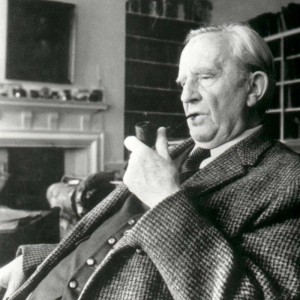 It’s Jeff again, here to talk about the Lord of the Rings. The final volume of the three volume set was published, surprise, surprise, on October 20, 1955. I read these books for the first time a long, long time ago when I was about 12. Yes, first time. I own and have re-read them countless times, mostly in English but several times in German. Of course I have seen the absolutely spectacular movies and really enjoy the BBC radio dramas.
It’s Jeff again, here to talk about the Lord of the Rings. The final volume of the three volume set was published, surprise, surprise, on October 20, 1955. I read these books for the first time a long, long time ago when I was about 12. Yes, first time. I own and have re-read them countless times, mostly in English but several times in German. Of course I have seen the absolutely spectacular movies and really enjoy the BBC radio dramas.
The Lord of the Rings is the sequel to The Hobbit. It was written between 1937 and 1949 in stages by J. R. R. Tolkien. When the publishers first approached him to write a sequel he proposed the book The Silmarillion, which was an early history of Middle Earth (the land where the Lord of the Rings and The Hobbit are set), but it was rejected. I have never been able to get through it, so I think that was a good choice! Tolkien was a full time professor at Oxford so his writing progressed slowly. The Lord of the Rings was originally supposed to be a children’s story, similar to The Hobbit, but it evolved into a much more serious and darker tale before it was completed. The original manuscript was 9,250 pages long. It has been officially translated into 38 languages.
Tolkien’s wish was for The Lord of the Rings to be published with the Silmarillion as a two volume set. Post war paper shortages and the high cost of printing caused the publisher to balk at this. They chose to split the Lord of the Rings into three books and the Silmarillion wasn’t published until after Tolkien’s death in 1973. Each book is divided into two parts. My favorite books are the Fellowship of the Ring (part 1) and the Return of the King (part 3). The Two Towers, particularly where Frodo and Sam are working their way to Mordor is extremely dark and tends to drag on a bit. It is still good, but the other parts are better.
The Lord of the Rings is an phenomenon. It is the second best selling book of all times (excluding religious works) having sold over 150 Million copies. (Charles Dickens “A Tale of Two Cities” is the first with over 200 Million copies. Check out Wikipedia’s list of best-selling books – very interesting.) The work has spawned multiple live action and animated movie series with action figures and all the marketing materials which is not so uncommon, but also board games, online role playing games, comic books, radio dramas, artwork and music. Led Zeppelin songs “Misty Mountain Top”, “Ramble On”, “The Battle of Evermore” and “Over the Hills and Far Away” are all supposedly inspired by Tolkien’s works. National Geographic did a special which is currently available on Netflix or you can stream for almost nothing here: National Geographic Beyond the Movie – The Lord of the Rings – The Fellowship of the Ring.
There are many groups that were built around Tolkien, but he most prominent is the Tolkien Society. There are university courses taught on Tolkien and his works. Being a linguist, the languages he created for the different races in the books were “real” and there are societies devoted to their research and propagation.
This post is a little short and a little light on facts, but there are literally thousands of web pages, classes and programs devoted to the subject. The best I can do here is guide you to some of them and tell you they are really, really good books. They are exceptionally well written, fun to read and full of meaning that relate even to today’s society. While I strongly recommend you read the Lord of the Rings trilogy, I suggest you read The Hobbit first. It is lighter and sets the stage. Don’t get lazy and just watch the (admittedly very good) movies. You will miss a lot!
Writing this post reminds me I haven’t re-read these books in a while. I think I’ll go pull out my copies and take another pass at them! If you don’t have a copy you can find a wide assortment at Amazon – Tolkien Books.
Jeff Jones
